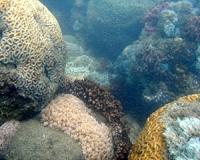 |
Davis CA (SPX) Apr 26, 2011 In the eerie bluish-purple depths of an Antarctic lake, scientists have discovered otherworldly mounds that tell tales of the planet's early days. Bacteria slowly built the mounds, known as stromatolites, layer by layer on the lake bottom. The lumps, which look like oversized traffic cones, resemble similar structures that first appeared billions of years ago and remain in fossil form as one of the oldest widespread records of ancient life. The Antarctic discovery could thus help scientists better understand the conditions under which primitive life-forms thrived. "It's like going back to early Earth," says Dawn Sumner, a geobiologist at the University of California, Davis. Sumner and her colleagues, led by Dale Andersen of the SETI Institute in Mountain View, Calif., describe the discovery in an upcoming issue of Geobiology. "These are just incredibly beautiful microbial landscapes," she says. Researchers have probed many Antarctic lakes to study the weird and wonderful microbes that live there; Andersen alone has dived into at least eight such lakes. But he says the discovery of the stromatolites rocketed East Antarctica's Lake Untersee "to the top of my list." Researchers study fossil stromatolites, from 3 billion years ago or more, to understand how life got a foothold on Earth. Today, stromatolites actively form in only a few spots in the ocean, like off the western coast of Australia and in the Bahamas. They also grow in some freshwater environments, like super-salty lakes high in the Andes and in a few of Antarctica's other freshwater lakes. But scientists have never seen anything like the size and shape of Untersee's stromatolites. Drawn by its extremely alkaline waters and high amounts of dissolved methane, Andersen and his colleagues traveled to Untersee in 2008 to drill through its permanent ice cover and collect water samples. Andersen was used to finding mats of bacterial growth in other Antarctic lakes, but nothing like the big mounds he saw when he dived under the ice at Untersee. Up to half a meter high, these purplish piles studded the lake's bottom like barnacles clinging to a ship hull. "It totally blew us away," Andersen says. "We had never seen anything like that." Samples of one of the mounds showed that it was made mostly of long, stringy cyanobacteria, ancient photosynthetic organisms. The bacteria may take decades to build each layer in Untersee's frigid waters, Sumner says, so the mounds may have taken thousands of years to accumulate. Oddly, the stromatolite mounds sat next to smaller, pinnacle-shaped lumps that researchers had seen in many other lakes. And the stromatolites were made mostly of Phormidium bacteria, while the pinnacles were made of another group, Leptolyngbya. To Sumner, that sharp distinction between bacterial composition on different shaped lumps says something significant about Untersee. "Everywhere else that we've looked you have a gradation between the structures," like in bacterial mats sprawling around Yellowstone's hot springs, she says. "There's something very special about this particular example that's allowing these large conical stromatolites to form." But scientists aren't sure yet what that something special is. Andersen's team has recently studied two other ice-covered Antarctic lakes, Vanda and Joyce, without finding large conical stromatolites there. Conditions vary from lake to lake, making each of them unique in their own frigid way; Lake Vanda, for instance, has a more transparent ice cover that lets more light penetrate. Lake Joyce has thicker ice, which constrains how far down photosynthesizing organisms can grow. Understanding what makes Untersee different would help scientists better figure out the limits on life, both today and in the long-distant past. "It's a real challenge to our understanding of how these communities developed," says Ian Hawes, a polar limnologist at the University of Canterbury in Christchurch, New Zealand. More answers should come this November, when Andersen's team is scheduled to return to Untersee to scrape up more samples of the ghostly blue mounds.
Share This Article With Planet Earth
Related Links the missing link Life Beyond Earth Lands Beyond Beyond - extra solar planets - news and science
 Achieving Eternal Life
Achieving Eternal LifeGothenburg, Sweden (SPX) Apr 25, 2011 Animals that reproduce asexually by somatic cloning have special mechanisms that delay aging provide exceptionally good health. Scientists at the University of Gothenburg have shown how colony-forming ascidians (or sea squirts) can activate the enzyme telomerase, which protects DNA. This enzyme is more active also in humans who attain an advanced age. "Animals that clone themselves, in whi ... read more |
|
| The content herein, unless otherwise known to be public domain, are Copyright 1995-2010 - SpaceDaily. AFP and UPI Wire Stories are copyright Agence France-Presse and United Press International. ESA Portal Reports are copyright European Space Agency. All NASA sourced material is public domain. Additional copyrights may apply in whole or part to other bona fide parties. Advertising does not imply endorsement,agreement or approval of any opinions, statements or information provided by SpaceDaily on any Web page published or hosted by SpaceDaily. Privacy Statement |